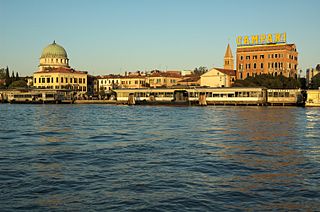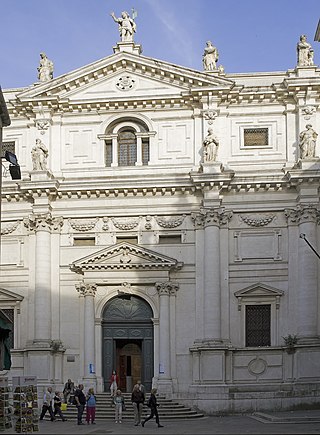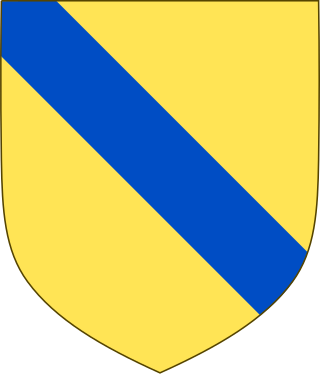
The Venetian Lagoon is an enclosed bay of the Adriatic Sea, in northern Italy, in which the city of Venice is situated. Its name in the Italian and Venetian languages, Laguna Veneta—cognate of Latin lacus, "lake"—has provided the English name for an enclosed, shallow embayment of salt water, a lagoon.

Murano is a series of islands linked by bridges in the Venetian Lagoon, northern Italy. It lies about 1.5 km (1 mi) north of Venice and measures about 1.5 km (1 mi) across with a population of just over 5,000. It is famous for its glass making. It was once an independent comune, but is now a frazione of the comune of Venice.

The Lido, or Venice Lido, is an 11-kilometre-long (7-mile) barrier island in the Venetian Lagoon, Northern Italy; it is home to about 20,400 residents. The Venice Film Festival takes place at the Lido late August/early September.

The Chiesa del Santissimo Redentore, commonly known as Il Redentore, is a 16th-century Roman Catholic church located on Giudecca (island) in the sestiere of Dorsoduro, in the city of Venice, Italy.

The Chiesa di San Salvatore is a church in Venice, northern Italy. Known in Venetian as San Salvador, is located on the Campo San Salvador, along the Merceria, the main shopping street of Venice. The church was first consecrated in 1177 by Pope Alexander III shortly after his reconciliation with Emperor Frederick Barbarossa at nearby San Marco. The present church, however, was begun in around 1508 by Giorgio Spavento and continued after his death the following year by Tullio Lombardo, Vincenzo Scamozzi and possibly Jacopo Sansovino. They built a large hall church, formed from three Greek crosses placed end to end. Each has a dome with a lantern to let light into the cavernous interior. The facade was added in 1663 by Giuseppe Sardi.

San Giorgio Maggiore is one of the islands of Venice, northern Italy, lying east of the Giudecca and south of the main island group. The island, or more specifically its Palladian church, is an important landmark. It has been much painted, featuring for example in a series by Monet.

Mazzorbo is one of various islands in the northern part of the Lagoon of Venice. Like the other islands in this part of the lagoon, it was the site one of the earliest settlements in the lagoon which predated the development of Venice. However, these islands then declined and were eventually abandoned. In the 1980s the architect Giancarlo De Carlo built a brightly coloured residential neighbourhood to help to repopulate Mazzorbo. In 2019 its population was 256. It is linked to Burano by a wooden bridge. It was once an important trading centre but is now known for its vineyards and orchards. Its main attraction is the fourteenth century church of Santa Caterina.

San Lazzaro degli Armeni is a small island in the Venetian Lagoon which has been home to the monastery of the Mekhitarists, an Armenian Catholic congregation, since 1717. It is one of the two primary centers of the congregation, along with the Mekhitarist Monastery of Vienna.

The Patriarch of Venice is the ordinary bishop of the Archdiocese of Venice. The bishop is one of only four patriarchs in the Latin Church of the Catholic Church. The other three are the Patriarch of Lisbon, the Patriarch of the East Indies and the Latin Patriarch of Jerusalem. Presently, the only advantage of this purely formal title is the bishop's place of honor in papal processions. In the case of Venice, an additional privilege allows the patriarch, even if he is not a cardinal, the use of the colour red in non-liturgical vestments. In that case, the red biretta is topped by a tuft, as is the custom with other bishops who are not cardinals.

Alessandro Vittoria was an Italian Mannerist sculptor of the Venetian school, "one of the main representatives of the Venetian classical style" and rivalling Giambologna as the foremost sculptors of the late 16th century in Italy, producing works such as Annunciation.

The House of Morosini was a powerful Venetian noble family that gave many doges, statesmen, generals, and admirals to the Republic of Venice, as well as cardinals to the Church.

The San Giorgio Monastery is a Benedictine monastery in Venice, Italy, located on the island of San Giorgio Maggiore. It stands next to the Church of San Giorgio Maggiore, which serves the monastic community. Most of the old monastic buildings currently serve as headquarters of the Cini Foundation.

San Giorgio Maggiore is a 16th-century Benedictine church on the island of the same name in Venice, northern Italy, designed by Andrea Palladio, and built between 1566 and 1610. The church is a basilica in the classical Renaissance style and its brilliant white marble gleams above the blue water of the lagoon opposite the Piazzetta di San Marco and forms the focal point of the view from every part of the Riva degli Schiavoni.

San Nicolò al Lido refers to both the San Nicolò Church and most importantly to its annexed Monastery of San Nicolò located in Venice, northern Italy. The two Catholic institutions are located in the northern part of the Lido di Venezia and house the relics of Saint Nicholas, patron of sailors. From this church, the traditional thanksgiving Mass of the Sposalizio del Mare is celebrated. The complex houses monks of the Franciscan order.

San Giorgio in Alga is an island of the Venetian lagoon, northern Italy, lying between the Giudecca and Fusina.

The House of Loredan is a Venetian noble family of supposed ancient Roman origin, which has played a significant role in shaping the history of the entire Mediterranean. A political dynasty, the family has throughout the centuries produced a number of famous personalities: doges, statesmen, magnates, financiers, diplomats, procurators, military commanders, naval captains, church dignitaries, writers, and lawyers.

The Lion of Saint Mark, representing Mark the Evangelist, pictured in the form of a winged lion, is an aspect of the Tetramorph. On the pinnacle of St Mark's Cathedral he is depicted as holding a Bible, and surmounting a golden lion which is the symbol of the city of Venice and formerly of the Venetian Republic.
Isola di San Clemente is a small island in the Venetian Lagoon in Italy. For centuries it housed a monastic settlement, and more recently an asylum. It is now the site of a luxury hotel.

The Bembo family was a noble Venetian family, part of the Venetian noble families of most ancient origins.



















